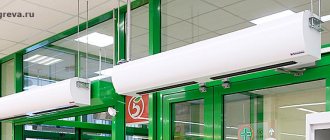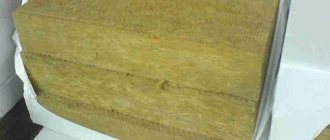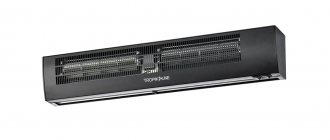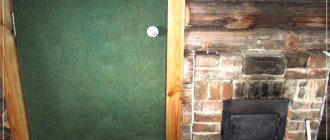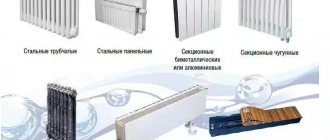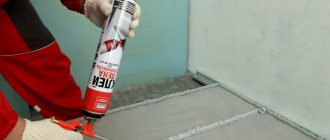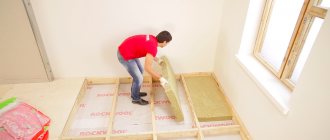Today, the thermal curtain is already a fairly common and popular heating device in many shops, garages, service stations, office buildings and other premises.
If you decide to install such a device, but have not yet decided which model to choose, let’s take a closer look at all the questions about the varieties and characteristics of individual types.
We will find out why they are needed in the first place and at the end we will list the main mistakes that you should avoid when purchasing and installing this unit.
What is it and what is it for?
Heat curtains are one of the types of heaters that operate on the principle of a fan. Externally, the device looks like a household air conditioner:
- has the shape of an elongated rectangle;
- There are holes on the top and bottom panels of the case to create air flow;
- metal body.
The unit differs from heaters in that they increase the air temperature in the room. This is their only task. The thermal curtain has two of them:
- cut off the path of cold air directed from the street into the apartment (main function);
- act as a heat source (secondary function).
The use of a thermal curtain for the entrance door allows you to save on heating the room during the cold season. Experts report that with the help of this device, electricity costs are reduced by more than a third. The savings are due to the absence of the need to connect other heat sources.
Thermal curtains belong to the category of semi-industrial heaters, so most devices have a discreet design and laconic forms. But the leading producers of this equipment understand that such devices do not always fit harmoniously into the interior of modern city apartments. And they offer consumers designer models that have a more attractive appearance. The front panel of such devices is made of impact-resistant glass in black or white.
Design and principle of operation
All thermal curtains are designed and operate on the same principle.
All types of thermal curtains are designed according to the same principle
- Air is drawn in through the holes on the top panel.
- Inside the case there is a fan responsible for creating air flow in the top-to-bottom direction.
- Next to the fan is a heat exchanger that heats the air passing through it.
- Some models may have a filter.
- At the bottom of the case there are openings that supply a powerful air flow.
Cold air passes through the heat exchanger and a warm air stream is formed at the outlet
The devices are equipped with two types of blower fans:
- radial (compact and lightweight);
- tangential (have an elongated shape).
The device is controlled using buttons on the front panel or remote unit, as well as using the remote control. The device can be equipped with an air temperature control sensor. Most models are equipped with a power cable for connecting to the mains. But there are devices on the body of which only a terminal block is installed.
Maintenance
During operation, ventilation systems are subject to contamination. Therefore, you should periodically disassemble the structure within the limits permitted by the instructions and clean the internal and external surfaces. Particular attention is paid to water models. Such curtains are sensitive to mechanical stress on the coolant circulation circuits, which creates a risk of leakage. Checking the integrity of water communications is the main task of maintaining such systems. Also, the air-thermal curtain has its own characteristics of content. When operating such systems, attention should be paid to electrical safety, eliminating the risks of overloads and short circuits in the wiring.
Advantages and disadvantages
Installing a thermal curtain over the front door has a number of advantages. The main advantage is to increase the level of comfort of living in the apartment. This is ensured by several effects:
- protection from outside penetration of dust, odors, smog;
- eliminating drafts;
- protection against penetration of flying insects;
- eliminating the leakage of air cooled by air conditioning from the room;
- maintaining a stable temperature inside the apartment.
No disadvantages of using thermal curtains were found. Equipment in this segment of heat fans is not an essential item, but its installation significantly improves the quality of life.
Installation method
All thermal curtains are divided into two groups according to the installation method: horizontal and vertical. There is also a small third group of such fan heaters with universal installation capabilities.
The simplest and therefore most common group of thermal curtains are horizontal installations. If the height of the opening is more than 3.5 m and there is a high probability of intensive opening of the doors, then in such cases experts recommend installing one horizontal and an additional vertical curtain. In particularly difficult cases, installation of horizontal heat curtains in several levels is allowed.
If, due to low ceilings or complex wall geometry, horizontal installation of the fan heater is not possible, you should choose vertical installations.
How to choose a thermal curtain by type
Equipment in this segment is classified according to several criteria:
- type of installation;
- location relative to the doorway;
- type of heat exchanger and its presence.
Classification by type of installation
Based on the type of installation, there are two types of models:
- built-in;
- mounted
Devices of the first type are needed where attachments are inappropriate or do not fit into the design of the room. Built-in models will help out in situations where the height of the lintel above the front door does not allow the installation of attachments.
Devices of the second type are the most commonly used in city apartments and private houses. They are installed on a wall or ceiling using brackets, take up little space and do not interfere with entry and exit.
Classification by location
Based on the type of location, there are several types of thermal curtains:
- horizontal;
- vertical;
- universal.
The most popular and convenient devices are the first type: horizontal. They are installed directly above the doorway and supply air flow from top to bottom. Installation is carried out in two ways:
- using brackets;
- on fastening connections.
Horizontal models can be installed on both sides of the opening, but such installation is unreasonable for city apartments. It is used to cut off cold air at the entrances to public places.
Vertical ones have more compact dimensions than horizontal ones. This is due to the peculiarity of their installation: on the right or left side of the door. It is permissible to install equipment whose height does not exceed 1/3 of the opening height.
Universal models can be installed in any position of the housing: vertical or horizontal. The mobility of such curtains has led to a higher demand for them than for other types of devices. Universal equipment is in demand in administrative buildings, city apartments and private houses.
Classification by type and presence of heat exchanger
According to this criterion, three types of curtains are distinguished:
- electrical;
- water;
- without heat exchanger.
Electrical
The most popular category of thermal curtains. Equipment of this type operates on a 220 V mains voltage and is lightweight and simple to operate. Serial marking:
- RS;
- R.M.;
- RT.
Most models of this type are equipped with a temperature controller. This is a justified decision, since the energy consumption of the curtains is quite high. When it gets warmer outside, you can adjust the device so that it produces cool air. A distinctive feature of this type of equipment is its inertia. In order for the device to reach operating mode, it needs some time, since the heat exchanger must heat up. For more powerful devices this process occurs faster.
The first models of thermal curtains used spiral heat exchangers. They have many disadvantages, the main ones being the “burning” of oxygen and dehumidification of the air in the room. Over time, most manufacturers abandoned this type of heat exchangers and in modern air curtains they install tubular or air-conductor ones. Such models always have a heating control function.
Mermen
Equipment of this type (serial marking RW) has lower power consumption, since they only need electricity to operate the fan and control system. In these models, the coolant that heats the air flow is hot water. In this regard, installation of equipment is complicated.
Water-type thermal curtains consume less electricity
The heat exchanger consists of thin pipes and resembles a car radiator. The water circuit is connected to the water supply through pipes located on the side panels of the device. It is also necessary to install a pipeline leading to the water intake point. The connection can be made to a heating or hot water system.
The second option is preferable because if the heating is turned off, heating will not be possible. But this is not a reason for disappointment, since the heating is turned off when the average daily temperature is positive and there is no need to heat the room.
Installation of a water heat curtain is also complicated by the fact that it requires an additional branch from the general circuit of the utility network. It must be provided for at the installation stage of the water supply distribution. Subsequently, it will be impossible to connect the equipment without damaging the external decoration of the premises.
An important design element of the device is a filter that retains sand and other impurities in the water. Since its quality often leaves much to be desired, regular filter cleaning will be required.
Without heat exchanger
Serial marking of air curtains without a heat exchanger is RV. Equipment of this type performs only one function - cutting off air masses located behind the front door. But at the same time it protects the interior space from smog.
Heat guns are also used as an additional heat source. Review of models in our next material:
Protection of indoor climate
First of all, air curtains are designed to prevent outside air from entering through open doorways into a certain climate zone (heated or cooled).
Air curtains reduce energy costs by keeping room air heated or cooled. Efficient air curtains will save up to 80% of energy loss through a doorway compared to a door without an air curtain. In winter, the air curtain creates a barrier that protects from cold air, and in summer, the air flow protects the hot air from outside
Taking into account the energy savings, the average payback period for an air curtain is between 2 and 5 years depending on use and climate conditions.
Although the doors are open, an air curtain separates the indoor and outdoor conditions
Pest and flying insect control
Air curtains protect your premises from insects. They will be stopped by an air barrier too powerful to penetrate. In catering establishments, bars, restaurants, cafes - this is extremely necessary. It should be especially noted that air curtains are needed in healthcare areas. Hospitals, clinics, dentists, etc. The presence of insects is not allowed in them.
Air curtain stops flying insects from entering from outside
You must choose the right air curtain to keep insects out. A powerful air stream is required along the entire doorway (stronger than standard ones).
Air curtain in refrigeration rooms
Due to the large temperature differences, it is highly recommended to install air curtains to reduce energy loss when the door is open. The higher the temperature difference between the inside and outside, the higher the energy loss if the door is not protected. Therefore, the payback period of the air curtain is very short and then the energy/money savings are very high. Not only will we save money by not letting air through the door, but we will also keep frozen goods in perfect condition and help reduce the cost of defrosting the refrigerator compartment.
Air curtains are the safest way to save a lot of energy in cold rooms
For refrigerators and freezers, air curtains are the safest way to protect against energy loss without any physical barrier that could lead to accidents or collisions at the doors. For example, when plastic strip curtains are used, the view through the doorway is limited and accidents to people or vehicles occur. Additionally, it prevents annoying and potentially dangerous fogging, moisture, and ice from forming in the door entry area.
Air curtains can be installed in all areas where doors are frequently opened.
Criteria for choosing a thermal curtain for an apartment
When choosing a thermal curtain, the first thing you need to pay attention to is power or air flow. Equipment with a low pumping rate is not able to cut off drafts and odors, while equipment with excessively high power causes a feeling of discomfort and heats not only the room, but also the street.
Based on performance, all thermal curtains are divided into three categories:
- low pressure;
- medium pressure;
- high-pressure.
Air curtains of the RS series are low-power, with a capacity of no more than 500 m³/hour. These are inexpensive models that are installed in openings no more than 150 cm high and up to 80 cm wide. They are not suitable for installation above the front door in apartments and houses. This requires medium-power models, the RM series.
These devices are installed in openings with a height of 200–300 cm. The equipment productivity is 1,500–2,000 m³/hour. Most manufacturers of thermal curtains of this series equip their products with remote units, which are installed in any place convenient for the owners. The equipment is controlled not only with the help of these units, but also with the help of remote controls (remote controls).
RT series devices are characterized by high productivity: more than 2500 m³/hour.
If equipment is chosen as the main source of heating the room, you will need a device with a power of 40 W/m³ of heated space. To provide additional heating, a device with a power of 20 W/m³ is sufficient. If the space in the apartment is wide, you can install several devices in a row.
One of the most important parameters is the length of the device. It should match the width of the doorway or overlap it. Otherwise, there will inevitably be gaps through which cold air will flow. The retail chain offers models with a length of 60–200 cm. For standard openings in apartments and private houses, equipment with a length of 80 cm is purchased.
Dimensions of horizontal heat curtains
The length of standard installations varies from 60 cm to 2 m. Such devices must be located at the top of the door or window opening. For maximum efficiency, you should choose a device that is exactly the width of the opening or slightly wider.
If the length of the opening is more than 2 m, then the best option would be to use several devices located at the top of the opening. It is necessary to install the devices as close to each other as possible so that there are no “dips” in the air flow.
Installation of a thermal curtain on the entrance door
In most cases, for the improvement of apartments, thermal curtains are purchased that operate on electricity and with a tubular or strip heat exchanger. It is easier to install such equipment than an air conditioner. But despite this, manufacturers insist that installation be carried out by specialists. However, any owner who knows how to drill walls and screw in self-tapping screws will be able to install a thermal curtain with his own hands.
You can install the thermal curtain yourself
- Selecting an installation location. The device can be mounted directly above the opening, fixing it on the wall or ceiling.
- Marking. In accordance with the dimensions of the equipment, marks are made on the wall or ceiling. Installation is carried out through mounting holes in the housing. All models are equipped with a mounting panel, brackets or other fasteners. In the location chosen for installing the air curtain, mark the fastening points.
- Installation of brackets. Using a drill and a drill, holes are made in the right places. The brackets are secured with dowel nails.
- Installation of equipment. Hang the device on the brackets.
- Installation of the control unit. On most models, to access the terminal blocks, power cable and remote control cable, you must remove the front panel. It is secured with 8 self-tapping screws. After which the cables are secured in the housing using clamps or seals (most often these auxiliary elements are not included in the package).
- Connect both cables to the terminal blocks, focusing on the markings.
- Install the front panel.
- Connect the curtain to the electrical network.
For equipment with remote control, installation of the unit is required, which is carried out in several stages.
- Unscrew the 4 screws and remove the front cover.
- Drill holes in the wall.
- Attach the housing to the wall.
- Install the front cover.
During installation, it is important not to touch the electric motor, as there is a risk of disturbing the alignment of its shaft and impeller. This can lead to noise and vibration during operation of the air curtain.
